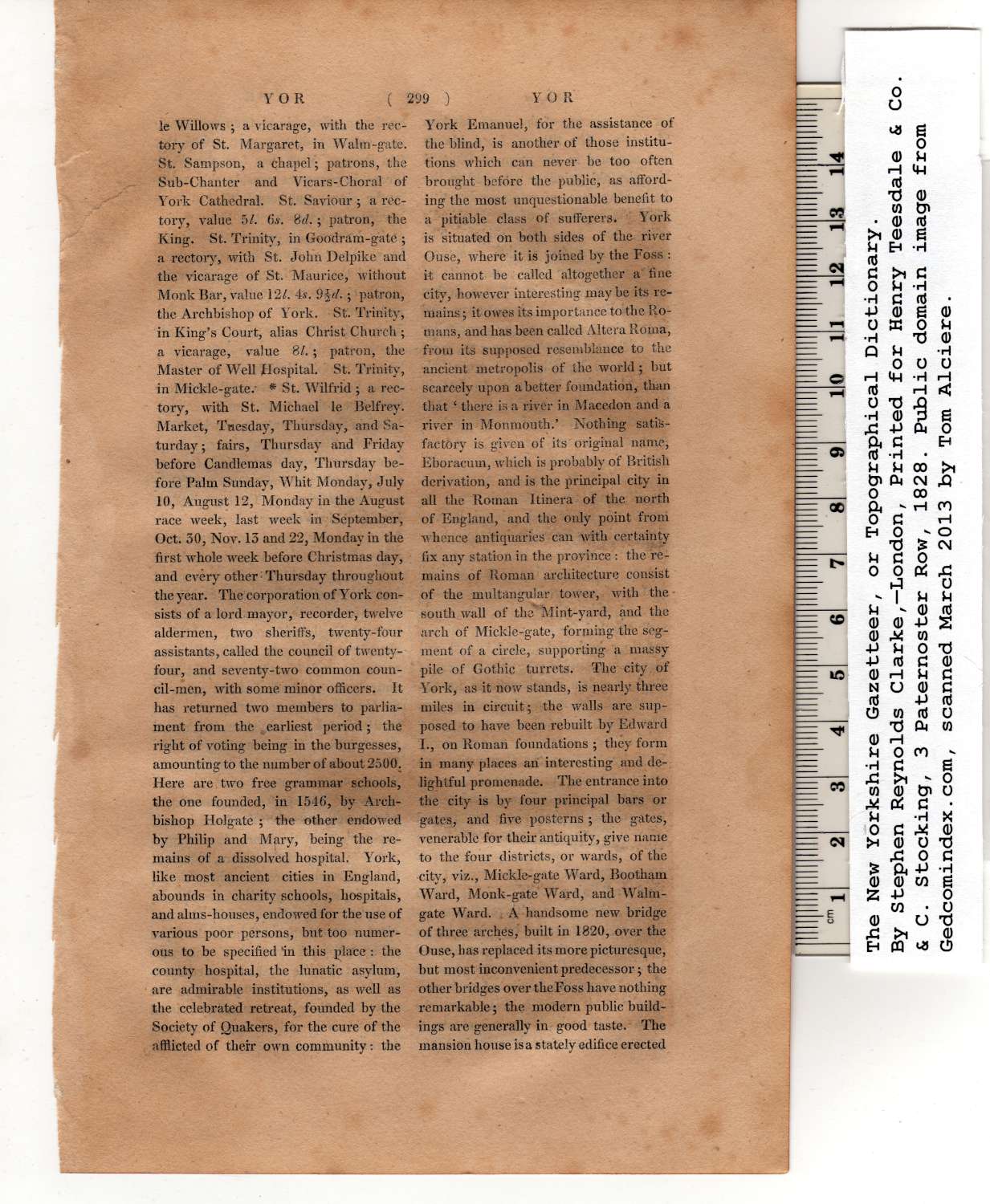|
le Willows ; a vicarage, with the rec-
tory of St. Margaret, in Walm-gate.
St. Sampson, a chapel; patrons, the
Sub-Chanter and Vicars-Choral of
York Cathedral. St. Saviour ; a rec-
tory, value 5/. 6s. Sd. ; patron, the
King. St. Trinity, in Goodram-gate ;
a rectory, with St. John Delpike and
the vicarage of St. Maurice, without
Monk Bar, value 12/. 4s. 9$d.; patron,
the Archbishop of York. St. Trinity,
in King’s Court, alias Christ Church ;
a vicarage, value 8/.; patron, the
Master of Well Hospital. St. Trinity,
in Mickle-gate.' * St. Wilfrid ; a rec-
tory, with St. Michael le Belfrey.
Market, Tuesday, Thursday, and Sa-
turday; fairs, Thursday and Friday
before Candlemas day, Thursday be-
fore Palm Sunday, Whit Monday, July
10, August 12, Monday in the August
race week, last week in September,
Oct. 30, Nov. 15 and 22, Monday in the
first whole week before Christmas day,
and every other: Thursday throughout
the year. The corporation of York con-
sists of a lord mayor, recorder, twelve
aldermen, two sheriffs, twenty-four
assistants, called the council of twenty-
four, and seventy-two common coun-
cil-men, with some minor officers. It
has returned two members to parlia-
ment from the , earliest period ; the
right of voting being in the burgesses,
amounting to the number of about 2500.
Here are two free grammar schools,
the one founded, in 1546, by Arch-
bishop Holgate ; the other endowed
by Philip and Mary, being the re-
mains of a dissolved hospital. York,
like most ancient cities in England,
abounds in charity schools, hospitals,
and alms-houses, endowed for the use of
various poor persons, but too numer-
ous to be specified in this place: the
county hospital, the lunatic asylum,
are admirable institutions, as well as
the celebrated retreat, founded by the
Society of Quakers, for the cure of the
afflicted of their own community: the |
York Emanuel, for the assistance of
the blind, is another of those institu-
tions which can never be too often
brought before the public, as afford-
ing the most unquestionable benefit to
a pitiable class of sufferers. York
is situated on both sides of the river
Ouse, where it is joined by the Foss :
it cannot be called altogether a fine
city, however interesting may be its re-
mains ; it owes its importance to the Ro-
mans, and has been called Altera Roma,
from its supposed resemblance to the
ancient metropolis of the world; but
scarcely upon abetter foundation, than
that ‘ there is a river in Macedon and a
river in Monmouth.’ Nothing satis-
factory is given of its original name,
Eboracum, which is probably of British
derivation, and is the principal city in
all the Roman Itinera of the north
of England, and the only point from
whence antiquaries can with certainty
fix any station in the province : the re-
mains of Roman architecture consist
of the multangular tower, with the
south wall of the Mint-yard, and the
arch of Mickle-gate, forming the seg-
ment of a circle, supporting a massy
pile of Gothic turrets. The city of
York, as it now stands, is nearly three
miles in circuit; the walls are sup-
posed to have been rebuilt by Edward
I., on Roman foundations ; they form
in many places an interesting and de-
lightful promenade. The entrance into
the city is by four principal bars or
gates, and five posterns ; the gates,
venerable for their antiquity, give name
to the four districts, or wards, of the
city, viz., Mickle-gate Ward, Bootham
Ward, Monk-gate Ward, and Walm-
gate Ward. A handsome new bridge
of three arches, built in 1820, over the
Ouse, has replaced its more picturesque,
but most inconvenient predecessor; the
other bridges over the Foss have nothing
remarkable; the modern public build-
ings are generally in good taste. The
mansion house is a stately edifice erected |
